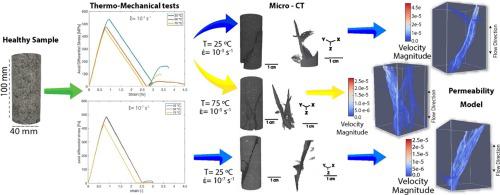当前位置:
X-MOL 学术
›
Geothermics
›
论文详情
Our official English website, www.x-mol.net, welcomes your feedback! (Note: you will need to create a separate account there.)
Thermo-mechanical behavior of a granodiorite from the Liquiñe fractured geothermal system (39°S) in the Southern Volcanic Zone of the Andes
Geothermics ( IF 3.9 ) Pub Date : 2020-09-01 , DOI: 10.1016/j.geothermics.2020.101828 J. Sepúlveda , G. Arancibia , E. Molina , J.P. Gilbert , M. Duda , J. Browning , T. Roquer , D. Morata , B. Ahrens , R. Bracke
Geothermics ( IF 3.9 ) Pub Date : 2020-09-01 , DOI: 10.1016/j.geothermics.2020.101828 J. Sepúlveda , G. Arancibia , E. Molina , J.P. Gilbert , M. Duda , J. Browning , T. Roquer , D. Morata , B. Ahrens , R. Bracke

|
Abstract Fractures and faults in granitic rocks play an important role in geothermal systems because they permit the circulation of hot fluids. However, the thermo-hydro-mechanical behavior of granitic rocks has predominantly been studied at temperatures exceeding 300 °C but many geothermal systems experience temperatures much lower than this. The aim of this study was to evaluate how the depth, temperature, and amount and rate of mechanical loading associated conditions, that are realistic in low temperature geothermal system, influence the physical properties of geothermal reservoir hosting rock. We carried out both room temperature and low temperature thermo-mechanical tests on a granodiorite sample from the Liquine area, Chile, and performed post-experimental X-ray microtomography analysis to numerically estimate the permeability of the generated fractures. The results showed that both rock strength and rock stiffness decreased with increments of temperature treatment related to the development of thermal crack damage at temperatures > 150 °C and through the development of sub-critical cracking at constant temperatures between 50–75 °C. Slowest deformed samples also exhibited lower strengths, attributed to the development of sub-critical cracking. The cyclic triaxial loading test indicated that significant mechanical fracture damage was only initiated above 80% of the peak stress regardless of the number of repeated loading cycles at lower stresses. Low-temperature treatment appears to be a conditioning factor, but not the dominant factor in controlling the physical properties of reservoir hosting rocks. Our findings indicate that thermal crack damage is likely important for developing microfracture related permeability at depths between around 2–6 km where the temperature is sufficiently high to induce thermal cracking. At shallower depths, such was previously estimated the reservoir of Liquine, thermal crack damage is only generated adjacent to fractures that remain open and circulate the hot fluids but sub-critical cracking over time reduces the strength of rocks in lower temperature regimes. These processes combined to produce a geothermal reservoir in Liquine which likely first required the presence of a highly fractured fault zone.
中文翻译:

安第斯山脉南部火山带 Liquiñe 断裂地热系统 (39°S) 花岗闪长岩的热力学行为
摘要 花岗岩中的裂缝和断层在地热系统中起着重要的作用,因为它们允许热流体循环。然而,花岗岩的热-水-力学行为主要在超过 300 °C 的温度下进行研究,但许多地热系统经历的温度远低于此温度。本研究的目的是评估低温地热系统中实际存在的深度、温度以及机械载荷相关条件的数量和速率如何影响地热储层围岩的物理性质。我们对智利 Liquine 地区的花岗闪长岩样品进行了室温和低温热机械测试,并进行了实验后的 X 射线显微断层扫描分析,以数值方式估计生成的裂缝的渗透率。结果表明,岩石强度和岩石刚度都随着温度处理的增加而降低,这与温度 > 150 °C 时热裂纹损伤的发展有关,并且通过在 50-75 °C 之间的恒定温度下发展亚临界裂纹。变形最慢的样品也表现出较低的强度,这归因于亚临界裂纹的发展。循环三轴加载试验表明,无论在较低应力下重复加载循环的次数如何,仅在峰值应力的 80% 以上才开始出现显着的机械断裂损伤。低温处理似乎是一个调节因素,但不是控制储层围岩物性的主导因素。我们的研究结果表明,热裂纹损伤可能对于在 2-6 公里左右的深度发展与微裂缝相关的渗透率很重要,那里的温度足够高以诱发热裂纹。在较浅的深度,如先前估计的 Liquine 储层,热裂纹损伤仅在保持开放并循环热流体的裂缝附近产生,但随着时间的推移,亚临界开裂会降低较低温度状态下岩石的强度。这些过程相结合,在 Liquine 产生了一个地热储层,这可能首先需要存在高度断裂的断层带。我们的研究结果表明,热裂纹损伤可能对于在 2-6 公里左右的深度发展与微裂缝相关的渗透率很重要,在那里温度足够高以引起热裂纹。在较浅的深度,如先前估计的 Liquine 储层,热裂纹损伤仅在保持开放并循环热流体的裂缝附近产生,但随着时间的推移,亚临界开裂会降低较低温度状态下岩石的强度。这些过程相结合,在 Liquine 产生了一个地热储层,这可能首先需要存在高度断裂的断层带。我们的研究结果表明,热裂纹损伤可能对于在 2-6 公里左右的深度发展与微裂缝相关的渗透率很重要,那里的温度足够高以诱发热裂纹。在较浅的深度,如先前估计的 Liquine 储层,热裂纹损伤仅在保持开放并循环热流体的裂缝附近产生,但随着时间的推移,亚临界开裂会降低较低温度状态下岩石的强度。这些过程相结合,在 Liquine 产生了一个地热储层,这可能首先需要存在高度断裂的断层带。之前对 Liquine 储层的估计如此,热裂纹损伤仅在保持开放并循环热流体的裂缝附近产生,但随着时间的推移,亚临界开裂会降低较低温度范围内岩石的强度。这些过程相结合,在 Liquine 产生了一个地热储层,这可能首先需要存在高度断裂的断层带。之前对 Liquine 的储层进行了估计,热裂纹损伤仅在保持开放并循环热流体的裂缝附近产生,但随着时间的推移,亚临界开裂会降低较低温度范围内岩石的强度。这些过程相结合,在 Liquine 产生了一个地热储层,这可能首先需要存在高度断裂的断层带。
更新日期:2020-09-01
中文翻译:

安第斯山脉南部火山带 Liquiñe 断裂地热系统 (39°S) 花岗闪长岩的热力学行为
摘要 花岗岩中的裂缝和断层在地热系统中起着重要的作用,因为它们允许热流体循环。然而,花岗岩的热-水-力学行为主要在超过 300 °C 的温度下进行研究,但许多地热系统经历的温度远低于此温度。本研究的目的是评估低温地热系统中实际存在的深度、温度以及机械载荷相关条件的数量和速率如何影响地热储层围岩的物理性质。我们对智利 Liquine 地区的花岗闪长岩样品进行了室温和低温热机械测试,并进行了实验后的 X 射线显微断层扫描分析,以数值方式估计生成的裂缝的渗透率。结果表明,岩石强度和岩石刚度都随着温度处理的增加而降低,这与温度 > 150 °C 时热裂纹损伤的发展有关,并且通过在 50-75 °C 之间的恒定温度下发展亚临界裂纹。变形最慢的样品也表现出较低的强度,这归因于亚临界裂纹的发展。循环三轴加载试验表明,无论在较低应力下重复加载循环的次数如何,仅在峰值应力的 80% 以上才开始出现显着的机械断裂损伤。低温处理似乎是一个调节因素,但不是控制储层围岩物性的主导因素。我们的研究结果表明,热裂纹损伤可能对于在 2-6 公里左右的深度发展与微裂缝相关的渗透率很重要,那里的温度足够高以诱发热裂纹。在较浅的深度,如先前估计的 Liquine 储层,热裂纹损伤仅在保持开放并循环热流体的裂缝附近产生,但随着时间的推移,亚临界开裂会降低较低温度状态下岩石的强度。这些过程相结合,在 Liquine 产生了一个地热储层,这可能首先需要存在高度断裂的断层带。我们的研究结果表明,热裂纹损伤可能对于在 2-6 公里左右的深度发展与微裂缝相关的渗透率很重要,在那里温度足够高以引起热裂纹。在较浅的深度,如先前估计的 Liquine 储层,热裂纹损伤仅在保持开放并循环热流体的裂缝附近产生,但随着时间的推移,亚临界开裂会降低较低温度状态下岩石的强度。这些过程相结合,在 Liquine 产生了一个地热储层,这可能首先需要存在高度断裂的断层带。我们的研究结果表明,热裂纹损伤可能对于在 2-6 公里左右的深度发展与微裂缝相关的渗透率很重要,那里的温度足够高以诱发热裂纹。在较浅的深度,如先前估计的 Liquine 储层,热裂纹损伤仅在保持开放并循环热流体的裂缝附近产生,但随着时间的推移,亚临界开裂会降低较低温度状态下岩石的强度。这些过程相结合,在 Liquine 产生了一个地热储层,这可能首先需要存在高度断裂的断层带。之前对 Liquine 储层的估计如此,热裂纹损伤仅在保持开放并循环热流体的裂缝附近产生,但随着时间的推移,亚临界开裂会降低较低温度范围内岩石的强度。这些过程相结合,在 Liquine 产生了一个地热储层,这可能首先需要存在高度断裂的断层带。之前对 Liquine 的储层进行了估计,热裂纹损伤仅在保持开放并循环热流体的裂缝附近产生,但随着时间的推移,亚临界开裂会降低较低温度范围内岩石的强度。这些过程相结合,在 Liquine 产生了一个地热储层,这可能首先需要存在高度断裂的断层带。


























 京公网安备 11010802027423号
京公网安备 11010802027423号